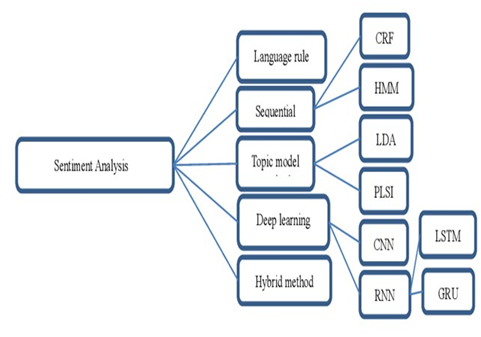Aspect Based Sentiment Analysis using Various Supervised Classification Techniques: An Overview
Main Article Content
Abstract
The Sentiment Analysis (SA) work is concerned with identifying aspect terms and categories and categorising emotions (positive, negatively, conflict, and neutral) in ratings and reviews. When it comes to subjectivity, it's typical to divide sentences into objective phrases that include accurate information and subjective statements that include express ideas, beliefs, and perspectives on a given topic. Various existing researchers have already done a lot of work in sentiment analysis with various methods, including aspect extraction. This paper proposed a systematic literature analysis of numerous sentiment analysis using supervised and unsupervised classification techniques. We investigate a few features extraction Natural language Processing (NLP) techniques used to identify aspects of machine learning for the detection of sentiment. An extensive experiment analysis, we discuss the findings of the study, challenges of the current and define the problem statement for the future direction
Article Details
References
Fuji Ren,Ye Wu,” Predicting User-Topic Opinions in Twitter with Social and Topical Context”, IEEE Trans. on affective computing, vol. 4, no. 4, October-December 2013.
Rui Xia, Feng Xu, Chengqing Zong, Qianmu Li, Yong Qi, and Tao Li,”Dual Sentiment Analysis:Considering Two Sides of One Review”, IEEE Trans.on Knowledge and Data Engineering, 2015
Xin Chen,Mihaela Vorvoreanu, and Krishna Madhavan,” Mining Social Media Data for Understanding Students’ Learning Experiences” IEEE trans. on learning technologies, vol. 7, no. 3, JulySeptember 2014.
Danushka Bollegala, David Weir, and John Carroll,” Cross-Domain Sentiment Classification Using a Sentiment Sensitive Thesaurus”, IEEE trans. on knowledge and data engineering, vol. 25, no. 8, August 2013.
Shulong Tan, Yang Li, Huan Sun, Ziyu Guan, Xifeng Yan, Jiajun Bu,
,Chun Chen, and Xiaofei He,” Interpreting the Public Sentiment Variations on Twitter”, IEEE trans. on knowledge and data engineering, vol. 26, no. 5, May 2014.
Chenghua Lin, Yulan He, Richard Everson, Member, IEEE, and Stefan Ru¨ger,” Weakly Supervised Joint Sentiment-Topic Detection from Text”, IEEE trans. on knowledge and data engineering, vol. 24, no. 6, June 2012.
Xiaolong Wang, Furu Wei, Xiaohua Liu, Ming Zhou, Ming Zhang,” Topic Sentiment Analysis in Twitter: A Graph-based Hashtag Sentiment Classification Approach”, ACM, CIKM’11, October 24–28, 2011, Glasgow, Scotland, UK, 2011.
Andrius Mudinas, Dell Zhang, Mark Levene,” Combining Lexicon and Learning based Approaches for Concept-Level Sentiment Analysis”, WISDOM’ 12, August 12, 2012, Beijing, China Copyright 2012, ACM.
Xiaohui Yu,Yang Liu, Jimmy Xiangji Huang, and Aijun An,,” Mining Online Reviews for Predicting Sales Performance: A Case Study in the Movie Domain”, IEEE Trans.On knowledge and data engineering, vol. 24, no. 4, April 2012.
LI Bing, Keith C.C. Chan, Carol OU,” Public Sentiment Analysis in Twitter Data for Prediction of A Company’s Stock Price Movements”, 2014 IEEE, 11th International Conference on e-Business Engineering.
Mr. Dharmesh Dhabliya, Mr. Rahul Sharma. (2012). Efficient Cluster Formation Protocol in WSN. International Journal of New Practices in Management and Engineering, 1(03), 08 - 17. Retrieved from http://ijnpme.org/index.php/IJNPME/article/view/7
C, S. L. ., Saxena, S. ., & Kumar, B. S. . (2023). Design Text Mining Classifier for Covid-19 by using the Machine Learning Techniques. International Journal of Intelligent Systems and Applications in Engineering, 11(2s), 240 –. Retrieved from https://ijisae.org/index.php/IJISAE/article/view/2622
M. Thelwall, K. Buckley, G. Paltoglou, and D. Cai, “Sentiment Strength Detection in Short Informal Text,” Am. Soc. Informational Sci. Technol., vol. 61, no. 12, pp. 2544– 2558, 2010.
P. P. Balage Filho and T. A. S. Pardo, “NILC{_}USP: A Hybrid System for Sentiment Analysis in Twitter Messages,” in Second Joint Conference on Lexical and ComputationalSemantics (*SEM), Volume 2: Proceedings of the Seventh International Workshop on Semantic Evaluation (SemEval 2013), 2013, vol. 2, no. SemEval, pp. 568–572.
N. Malandrakis, A. Kazemzadeh, A. Potamianos, and S. Narayanan, “SAIL?: A hybrid approach to sentiment analysis,” vol. 2, no. SemEval, pp. 438–442, 2013.
Ana Silva, Deep Learning Approaches for Computer Vision in Autonomous Vehicles , Machine Learning Applications Conference Proceedings, Vol 1 2021.
Juan Garcia, Guðmundsdóttir Anna, Johansson Anna, Maria Jansen, Anna Wagner. Optimal Decision Making in Supply Chain Management using Machine Learning. Kuwait Journal of Machine Learning, 2(4). Retrieved from http://kuwaitjournals.com/index.php/kjml/article/view/209
A. Mudinas, D. Zhang, and M. Levene, “Combining lexicon and learning based approaches for concept-level sentiment analysis,” Proc. First Int. Work. Issues Sentim. Discov. Opin. Min. - WISDOM ’12, pp. 1–8, 2012.
L. Zhang, R. Ghosh, M. Dekhil, M. Hsu, and B. Liu, “Combining lexicon-based and learning-based methods for Twitter sentiment analysis,” Int. J. Electron. Commun. Soft Comput. Sci. Eng., vol. 89, pp. 1–8, 2015
Li J, Qiu L. A sentiment analysis method of short texts in microblog. In2017 IEEE International Conference on Computational Science and Engineering (CSE) and IEEE International Conference on Embedded and Ubiquitous Computing (EUC) 2017 Jul 21 (Vol. 1, pp. 776-779). IEEE.

